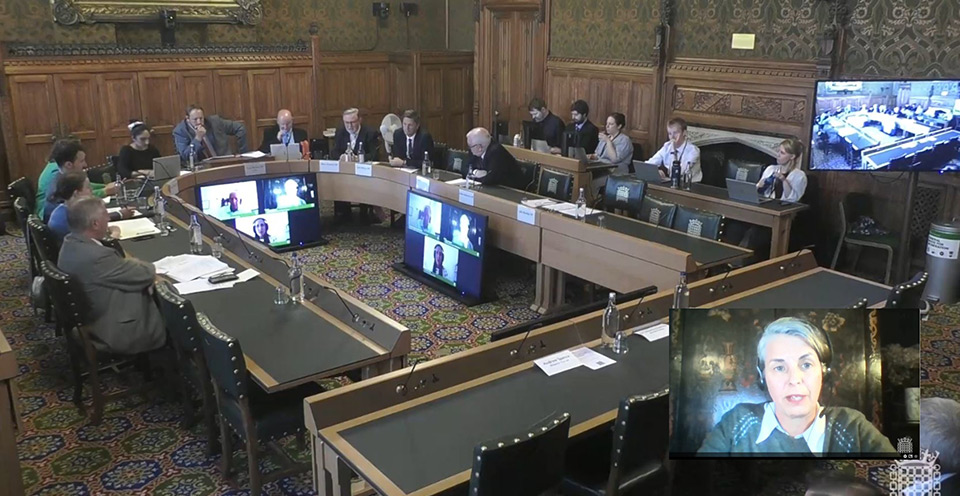Greater transparency is needed on the military use of PFAS during peacetime and conflict.

With military spending set to double by 2030, it is vital that we have a clearer understanding of the extent to which militaries are using toxic ‘forever chemicals’, and the risks they pose to civilians and personnel argued Linsey Cottrell at a UK parliamentary committee hearing in June.
Forever chemicals
The use of PFAS — otherwise known as ‘forever chemicals’ — is widespread in contemporary materials from everyday items such as food wrapping and clothing to high-tech aerospace components and medical equipment. The OECD has identified 4,730 PFAS in global use and due to their persistence in the environment, many are found in people, animals, water, soils and air. Some PFAS are known to be harmful to human and wildlife health, yet the type and certainty of health impacts varies. Concern around exposure to these synthetic and ubiquitous chemicals has seen increasing political and media interest. However, the available data concerning the use of PFAS in military applications is limited — a question Linsey was invited to address at the opening session of the UK parliament’s Environmental Audit Committee’s new PFAS inquiry. This blog summarises Linsey’s contribution to the session.
Spending more on PFAS
UK MoD expenditure on weapons and munitions in 2023-24 with UK industry and commerce amounted to £1.4bn. Total defence exports in 2023 came to 14.8bn. Together, these represent a large volume of military materiel containing unknown but significant quantities of PFAS. This includes their use in military aircraft, munitions, missile systems, protective clothing, energy and battery storage, electronics, refrigerants, fire suppression and firefighting foams, sealants, cleaning fluids, and waterproofing. With defence expenditure projected to more than double to 5% of GDP by 2030, the volume of PFAS connected with military activity will also substantially increase.
Civilian exposures
Information on military sources largely relates to the use of PFAS-containing fire-fighting foams on military bases and fire training areas rather than their wider use and release outside of the military estate — for example in conflict settings. The impacts upon communities where PFAS-containing equipment is used or disposed of are little understood. Whereas some studies have been carried out concerning the occupational exposure of military personnel to contaminants under certain scenarios — such as exposure to airborne contaminants from burn pits used in Afghanistan — it is typical for such studies to only focus on military exposures to the exclusion of local communities.
Responding to a question concerning the interaction of PFAS with other chemicals, Linsey stated “when you detonate explosives, there is always a residual explosive component left, such as TNT, which is a carcinogenic, mixed with metals and PFAS. I am not aware of any research that has looked at that cocktail mix when it gets airborne and is dispersed either in a training exercise on a military estate or… in a conflict setting, and how that impacts the local communities where it is being used.”
Peacetime pollution
To date, the attention that military PFAS use has attracted has related to active and former military sites, many of which carry a potential pollution legacy. Monitoring and evaluation of the results from these potentially contaminated sites is vital to understand the likely scale of risk and identify who may be affected. To do this, strong guidance is needed on the assessment of PFAS so that regulatory authorities are properly equipped to evaluate and help manage the risks through the planning and regulatory process.
One the major challenges is understanding the true scale of the problem. The Forever Pollution Project (FPP) across Europe relied on open source data to identify 79 military locations within the UK presumed to be sites with PFAS contamination. However, the list is not exhaustive: for example, of the 16 range sites operated and managed by QinetiQ under their long-term partnership agreement with the UK MoD, only three are included on the FPP list. Data from UK Environment Agency risk mapping for PFAS contaminated sites — which includes military sites — is not currently in the public domain.
The FPP has cited a general lack of co-operation from European militaries. Unfortunately, there is also a lack of transparency within the UK MoD’s public reporting. Whilst the Defence Environmental Protection Regulator — as part of the Defence Safety Authority (DSA) — is responsible for third-party assurance, regulation, and enforcement of environmental protection across the MoD, the recent Annual Assurance report does not refer to PFAS use, control or contaminated sites. Because no detail is openly provided in either the DSA or the MoD’s Annual report, Freedom of Information requests are one of the few means to obtain this information.
The DSA assurance report is also worrying in that it cites resource and training capacity limitations. Only limited assurance was given across all the organisations audited on environmental protection, with additional data and evidence required to provide a more comprehensive assessment. The MoD’s general position is to comply with environmental legislation, and there is a memorandum of understanding between the MoD and the Environment Agency, however a lack of resourcing appears as a common theme for organisations to their roles and responsibilities. For example, the MoD’s existing land quality assessment framework is serviced by a sole provider. There have previously been four providers. A lack of transparency invites speculation regarding the sites of concern and absence of a real reckoning of potential risks, undermining confidence in the MoD’s accountability.
Future trends
On future restrictions and legislation, the risk from blanket exemptions for the military was also highlighted. Proposals for a PFAS ban in the EU include a clause for essential societal use. Such exemptions often apply to the military regarding environmental legislation. Examples includes exemptions for the military use of F-gases and regulations on the restrictions on hazardous substances in electronic equipment. UK REACH also allows for defence exemptions, for example on the recent decision to ban toxic lead ammunition to “stop lead from contaminating soil and leaching into rivers”. With respect to implementing future legislation, it is very important that the military exemptions and the associated risks are properly understood and that there are proper evaluations of that military use, with careful and cautious consideration of when defence exemptions may be applied.
Simon Watkins is CEOBS’ Operations Coordinator; Linsey Cottrell was CEOBS Environmental Policy Officer and our thanks to her for representing CEOBS at the hearing. The full transcript of the hearing is available to download from the houses of parliament website, a recording of the session can be viewed here. For an in-depth discussion of military PFAS, see Linsey’s blog posted February 2025.





